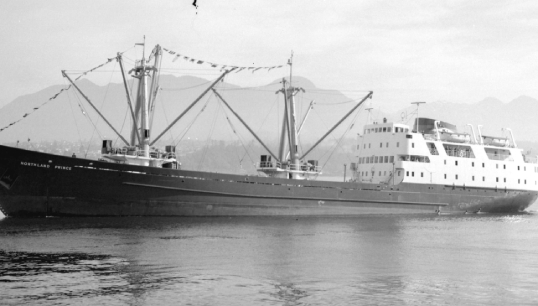Northland Prince

A lucky find
It found the 14-year-old passenger/cargoship Northland Prince, originally constructed for a Canadian coastal service, which was laid up in Vancouver. The 3,150gt vessel was bought for some £800,000, underwent a £1.2m refit in Southampton, and emerged as the first RMS St Helena in the summer of 1978.
The build
Built by the Burrard Drydock Company of North Vancouver in 1963, and powered by a 4,200bhp Stork-Werkspoor diesel engine giving a service speed of 16.5 knots, Northland Prince had spent the first 13 years of its career carrying freight, mail and up to 88 passengers between British Columbia and Alaska.
Deployments
Withdrawn from the weekly service linking Vancouver with the Queen Charlotte Islands in October 1976, Northland Prince was acquired for the St Helena Shipping Company, which had been created as a public/private joint venture with Falmouth-based Curnow Shipping.
Following a trial voyage to St Helena early in 1978, the ship was upgraded for its new role, with new lifeboats, air conditioning, and improved accommodation for as many as 76 passengers. RMS St Helena made its first voyage on the lifeline service between Avonmouth, the Canary Islands, Ascension, Jamestown and Cape Town in October 1978 and was to prove popular was passengers and crew alike.
The Falklands
In May 1982, the vessel was requisitioned by the British government to serve in the Falklands task force and was modified at Portsmouth Naval Dockyard for its new role providing technical and logistical support to Royal Navy minesweepers. Work included the fitting of a helicopter flight deck, four 20mm Oerlikon guns, extra fuel tanks and replenishment at sea equipment.
RMS St Helena’s military service lasted until September 1983 and included active support to RN mine-hunting and clearing operations, and later as a troop transport and storage ship in the Falklands.
Fired and replaced
Back in normal service after a major refit in Falmouth, RMS St Helena suffered a serious engineroom fire in October 1984. Crew members managed to bring the blaze under control soon after abandon-ship procedures began, and the vessel was towed to Dakar for repairs.
While taken up from trade during the Falklands War, the ship’s regular role had been filled by the former Blue Funnel vessel Centaur. The use of the 8,236grt substitute ship highlighted the limitations of the much smaller RMS St Helena and work began in 1986 on a project to develop a purpose-built replacement. The new RMS entered into service in November 1990 and the former Northland Prince, now named Avalon, was sold to a Maltese firm which planned to use the vessel for cruises between South Africa and the Seychelles.
The cruises proved unsuccessful, and after a period under arrest the ship was sold at auction in 1993 to Indoceanic Maritime Enterprises in Mauritius and renamed Indoceanique. The ship was refitted in Durban and was used for an inter-island passenger/cargo service until being sold for scrap, being broken up at Alang, India, in 1996.
Northland Prince fact file
How fast was Northland Prince?
Northland Prince had a service speed of 16.5 knots
Which ship replaced Northland Prince in 1982?
Centaur replaced Northland Prince when it was requisitioned for use in the Falklands War
How much was Northland Prince bought for in 1977?
Northland Prince was bought for £800,000
Contribute
Are you knowledgeable about this vessel?
Submit your contribution to this article to our editorial team.
Write to usView more ships of the past
HMS Beagle
Launched 200 years ago, HMS Beagle has been described as one of the most important ships in history – thanks to the observations on evolution and natural selection that its famous passenger Charles Darwin made during a five-year voyage around the world between 1831 and 1836.
Common.ReadMoreHMS Beagle
Nicola
Launched in December 1967 at the Austin & Pickersgill (A&P) yard in Sunderland, the 9,034grt general cargoship Nicola was the first in a series of more than 200 British-designed vessels intended to replace the 'cheap and cheerful' Liberty ships built by the US during the Second World War.
Common.ReadMoreNicola
Ruahine
Entering into service just over 70 years ago, the Ruahine was the last passenger-carrying ship built for the New Zealand Shipping Company (NZSC), and the third to bear the name – which means 'wise woman' in Māori.
Common.ReadMore